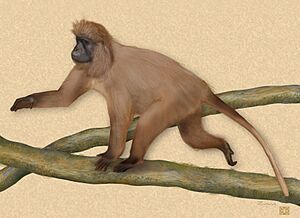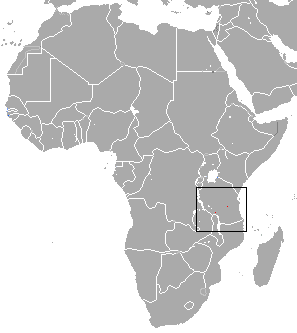Highland mangabey facts for kids
Quick facts for kids Kipunji |
|
|---|---|
 |
|
| Conservation status | |
| Scientific classification | |
| Genus: |
Rungwecebus
|
| Species: |
kipunji
|
 |
|
| Kipunji range | |
The kipunji (Rungwecebus kipunji), also known as the highland mangabey, is a species of Old World monkey that lives in the highland forests of Tanzania. The kipunji has a unique call, described as a 'honk-bark', which distinguishes it from its relatives, the grey-cheeked mangabey and the black crested mangabey, whose calls are described as 'whoop-gobbles'.
The kipunji was independently discovered by researchers from the Wildlife Conservation Society, the University of Georgia, and Conservation International, in December 2003 and July 2004, making it the first new African monkey species discovered since 1984. Originally assigned to the genus Lophocebus, genetic and morphological data showed that it is more closely related to the baboons (genus Papio) than to the other mangabeys in the genus Lophocebus. Scientists subsequently assigned it to a new genus, Rungwecebus, named after Mount Rungwe. The kipunji is the first new monkey genus to be discovered since Allen's swamp monkey in 1923.
Zoologists were initially skeptical of the existence of the kipunji until its discovery, as traditional tales of the Nyakyusa people described the monkey as both real and mythical.
Description
The kipunji's relatively long pelage is light or medium brown with white on the end of the tail and the ventrum. The pelage close to the hands and feet tends to be a medium to dark brown. Its hands, feet, and face are all black. These primates do not appear to show any sexual dimorphism in relation to pelage coloration. Adult male kipunjis have been observed at a typical length of 85–90 cm (33–35 in) and are estimated to weigh between 10 and 16 kg (22 and 35 lb). One feature, in combination with their pelage coloration, that helps to separate kipunjis from their Cercocebus and Lophocebus relatives is the broad crest of hair on the crown of their heads.
Distribution and habitat
Around 1,100 of the animals live in the highland Ndundulu Forest Reserve, adjacent to Udzungwa Mountains National Park, and in a disjunct population 250 miles away on Mount Rungwe and in Kitulo National Park, which is adjacent to it. The forest at Rungwe is highly degraded, and fragmentation of the remaining forest threatens to split that population into three smaller populations. The Ndundulu forest is in better shape, but the population there is smaller.
Conservation
The kipunji is classified as an endangered species on the IUCN Red List. It was included in the list of "The World's 25 Most Endangered Primates" in 2006 and 2008.
Its range is restricted to 17.7 km2 (6.8 sq mi) of forest in the two isolated regions, the Ndundulu forest and the Rungwe-Livingstone forest.
Threats
The kipunji faces multiple threats, primarily stemming from human activities such as logging, charcoal making, illegal hunting, and unmanaged resource extraction have been commonplace in the Rungwe-Kitulo forests, leading to habitat fragmentation and degradation. The narrow corridors linking different forest sections are encroached by farmers, further exacerbating the fragmentation of population units. Kipunjis are hunted using log traps and dogs, mainly during January to April in retribution for crop-raiding incidents. Both Kilombero Nature Forest Reserve and Mount Rungwe Nature Reserves lack adequate management resources to counter these threats.


